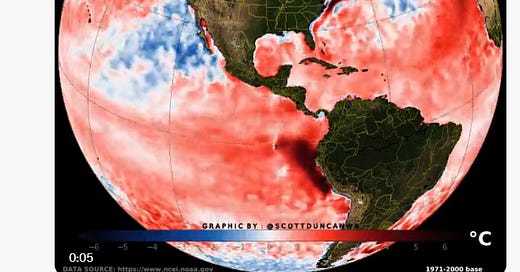Almost everything we know about hurricanes and climate change, just ain't so...
New study shows that the potential intensity of tropical cyclones DECREASES with increasing sea surface temperature.
In a previous post about hurricanes I have shown:
Observed landfall hurricane data for the US shows no trend in the frequency of hurricanes striking the coast since 1850, contradictory to claims by the IPCC that such an increase is already occurring. Furthermore, a recent analysis of precipitation associated with global hurricanes over the last few decades shows significant decreases in rain rate, also contradictory to expectations of the IPCC. There has been no increase in the frequency or precipitation intensity of hurricanes related to climate change.
Hurricane season in the US is kicking into high gear
·Hurricane season in the US… In the United States, hurricane season primarily refers to the Atlantic and Eastern North Pacific regions, as these are the areas most likely to be impacted by tropical cyclones. Atlantic Hurricane Season (which includes the North Atlantic Ocean, the Gulf of Mexico, and the Caribbean Sea):
However, I am continuously bombarded by claims that although there may be fewer storms the warmer sea surface temperatures (SST) that we are seeing today will drive these storms to be higher energy and thus potentially more intense. For example, on a website run by the National Oceanic and Atmospheric Administration, it states:
Recent studies have shown a link between ocean surface temperatures and tropical storm intensity – warmer waters fuel more energetic storms.
Or CNN making the following claims in an article titled, “What record warm ocean temperatures could mean for hurricane season”:
It is important because warm ocean water breeds stronger, bigger and wetter storms. It gives hurricanes the energy they need to grow and sometimes rapidly intensify, something hurricane forecasters told CNN we could see more of this season. Warm oceans can also lead to more evaporation and wring out more rainfall falling from any storms.
Or social media posts such as this getting over 500k views:
The IPCC has made several statements about the relationship between sea surface temperatures (SST) and tropical cyclone (TC) intensity.
The maximum sustained winds of tropical cyclones have increased in some basins over the last few decades, and this trend is likely a consequence of rising sea surface temperatures, among other factors. Warm SSTs provide the energy needed for cyclone formation and intensification.
Under future warming scenarios, most models project an increase in the intensity of tropical cyclones. While the global frequency of all tropical cyclones might either decrease or remain essentially unchanged, the frequency of the most intense storms (e.g., category 4 and 5) is projected to increase.
Tropical cyclones will produce more rainfall in a warmer climate, primarily due to the increased moisture-carrying capacity of warmer air. This enhanced rainfall can contribute to more severe flooding when these storms make landfall.
Some studies suggest that we might see more frequent cases of rapid intensification of tropical cyclones in a warmer world, which can be particularly challenging for forecasters and for preparedness measures.
Finally, the IPCC claims that there's a clear theoretical and model-based understanding that supports these findings, but warns the observational record – especially in certain ocean basins – can be limited, both in length and quality.
However, what does the latest science say about the ‘clear theoretical’ basis for an increase in the potential intensity of hurricanes and increasing SSTs?
Keep reading with a 7-day free trial
Subscribe to Irrational Fear to keep reading this post and get 7 days of free access to the full post archives.





